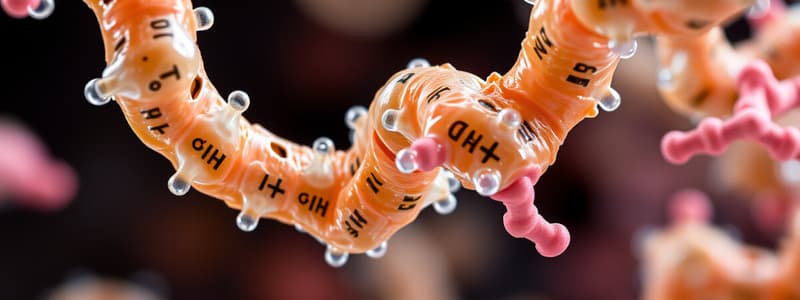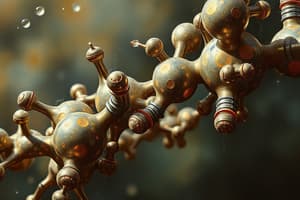Podcast
Questions and Answers
What is the primary role of enzymes in chemical reactions?
What is the primary role of enzymes in chemical reactions?
- To get consumed during the reaction
- To alter the substrates involved
- To act as catalysts that speed up reactions (correct)
- To provide energy for the reaction
Which site on an enzyme is primarily involved in substrate binding?
Which site on an enzyme is primarily involved in substrate binding?
- Enzyme site
- Allosteric site
- Active site (correct)
- Catalytic site
What does the term 'denaturation' refer to in relation to enzymes?
What does the term 'denaturation' refer to in relation to enzymes?
- The breakdown of protein structure due to environmental factors (correct)
- The process of enzyme-substrate interaction
- The activation of enzyme by co-factors
- The modification of substrate structure
What is the optimal temperature for enzyme activity mentioned?
What is the optimal temperature for enzyme activity mentioned?
What role do coenzymes play in enzyme activity?
What role do coenzymes play in enzyme activity?
Which model describes the enzyme-substrate interaction?
Which model describes the enzyme-substrate interaction?
What is a characteristic of enzymes regarding their usage?
What is a characteristic of enzymes regarding their usage?
What is a characteristic of enzymes that distinguishes them from other proteins?
What is a characteristic of enzymes that distinguishes them from other proteins?
What happens to an enzyme when it undergoes denaturation?
What happens to an enzyme when it undergoes denaturation?
Which option best describes the role of the allosteric site on an enzyme?
Which option best describes the role of the allosteric site on an enzyme?
Which factor can affect enzyme activity by altering its shape?
Which factor can affect enzyme activity by altering its shape?
What is the induced fit model of enzyme activity?
What is the induced fit model of enzyme activity?
What must occur for an enzyme to function effectively at its optimum temperature?
What must occur for an enzyme to function effectively at its optimum temperature?
Which of the following statements about enzymes is incorrect?
Which of the following statements about enzymes is incorrect?
Flashcards
Enzymes
Enzymes
Substances that accelerate chemical reactions without being altered themselves.
Lock and Key Model
Lock and Key Model
The model explaining enzyme-substrate specificity, like a key fitting a lock.
Coenzymes
Coenzymes
Non-protein molecules (often vitamins) that enhance enzyme activity.
Active Site
Active Site
Site on an enzyme where the substrate binds and the reaction occurs.
Signup and view all the flashcards
Allosteric Site
Allosteric Site
Site on an enzyme where inhibitors bind, reducing or stopping enzyme activity.
Signup and view all the flashcards
Substrate
Substrate
The substance upon which an enzyme acts.
Signup and view all the flashcards
Denaturation
Denaturation
Alteration of an enzyme's structure (often by heat), affecting its active site.
Signup and view all the flashcards
Induced Fit Model
Induced Fit Model
Model where the active site changes shape to precisely fit the substrate.
Signup and view all the flashcards
Inhibitor
Inhibitor
Molecule that reduces enzyme activity.
Signup and view all the flashcards
Optimum pH
Optimum pH
Optimal acidity or alkalinity for enzyme function.
Signup and view all the flashcards
Optimum Temperature
Optimum Temperature
Optimal heat for enzyme function (typically 37°C in humans).
Signup and view all the flashcards
Catalysts
Catalysts
Speed up chemical reactions.
Signup and view all the flashcards
Nucleic acids
Nucleic acids
Polymers composed of nucleotides, containing genetic information.
Signup and view all the flashcards
Nucleotide's components
Nucleotide's components
Phosphate group, five-carbon sugar, and a nitrogen base.
Signup and view all the flashcardsStudy Notes
Enzyme Characteristics
- Enzymes function as catalysts, speeding up chemical reactions without altering themselves.
- All enzymes are proteins, constructed from sequences of amino acids.
- Each enzyme is specific to a substrate, exemplified by the "lock and key" model.
- Enzymes often work alongside coenzymes, non-protein molecules (e.g., vitamins) that enhance enzyme activity.
- They are reusable and can participate in multiple chemical reactions.
- Enzymes lower the activation energy required for reactions, facilitating faster progress.
Binding Sites
- Enzymes have two critical binding sites:
- Active site: where the substrate binds, allowing the reaction to occur.
- Allosteric site: where inhibitors (toxins) attach, reducing or halting enzyme activity.
Substrates and Denaturation
- A substrate is the specific substance upon which an enzyme acts.
- Denaturation refers to the alteration of enzyme structure, particularly due to high temperatures (above 50°C), affecting the active site.
Enzyme-Substrate Interaction
- The interaction is explained by the Induced Fit Model, where the active site undergoes a conformational change to fit the substrate precisely.
Enzyme Activity Factors
- pH Levels: Each enzyme has an optimum pH where it performs best.
- Temperature: Each enzyme operates optimally at a specific temperature (typically around 37°C for human enzymes).
- Enzyme Concentration: Increasing enzyme concentration can enhance reaction rates, provided there's sufficient substrate.
- Inhibitors: Molecules that decrease enzyme activity, impacting overall reaction rates.
Nucleic Acids
- Nucleic acids contain carbon (C), hydrogen (H), oxygen (O), nitrogen (N), and phosphorus (P).
- They are polymers made of nucleotides, which consist of three components:
- A phosphate group
- A five-carbon sugar
- A nitrogen base
Enzyme Characteristics
- Enzymes function as catalysts, speeding up chemical reactions without altering themselves.
- All enzymes are proteins, constructed from sequences of amino acids.
- Each enzyme is specific to a substrate, exemplified by the "lock and key" model.
- Enzymes often work alongside coenzymes, non-protein molecules (e.g., vitamins) that enhance enzyme activity.
- They are reusable and can participate in multiple chemical reactions.
- Enzymes lower the activation energy required for reactions, facilitating faster progress.
Binding Sites
- Enzymes have two critical binding sites:
- Active site: where the substrate binds, allowing the reaction to occur.
- Allosteric site: where inhibitors (toxins) attach, reducing or halting enzyme activity.
Substrates and Denaturation
- A substrate is the specific substance upon which an enzyme acts.
- Denaturation refers to the alteration of enzyme structure, particularly due to high temperatures (above 50°C), affecting the active site.
Enzyme-Substrate Interaction
- The interaction is explained by the Induced Fit Model, where the active site undergoes a conformational change to fit the substrate precisely.
Enzyme Activity Factors
- pH Levels: Each enzyme has an optimum pH where it performs best.
- Temperature: Each enzyme operates optimally at a specific temperature (typically around 37°C for human enzymes).
- Enzyme Concentration: Increasing enzyme concentration can enhance reaction rates, provided there's sufficient substrate.
- Inhibitors: Molecules that decrease enzyme activity, impacting overall reaction rates.
Nucleic Acids
- Nucleic acids contain carbon (C), hydrogen (H), oxygen (O), nitrogen (N), and phosphorus (P).
- They are polymers made of nucleotides, which consist of three components:
- A phosphate group
- A five-carbon sugar
- A nitrogen base
Studying That Suits You
Use AI to generate personalized quizzes and flashcards to suit your learning preferences.




